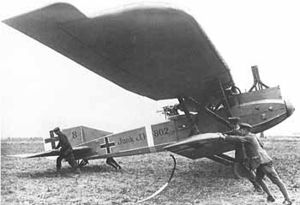| J.I | |
|---|---|
| Role | Observation and liaison aircraft |
| Manufacturer | Junkers |
| Designer | Otto Mader |
| First flight | 28 January 1917[1] |
| Introduction | 1917 |
| Retired | 1918 |
| Primary user | Luftstreitkräfte |
| Number built | 227 |
The Junkers J.I (manufacturer's designation J 4; not to be confused with the earlier, pioneering J 1 all-metal monoplane of 1915/16) was a German "J-class" armored sesquiplane of World War I, developed for low-level ground attack, observation and Army cooperation. It is especially noteworthy as being the first all-metal aircraft to enter mass production; the aircraft's metal construction and heavy armour was an effective shield against small arms fire over the battlefield.[2]
Development[]
In an extremely advanced design, a single-unit steel "bathtub" that ran from just behind the propeller to the rear crew position acted not only as armour, but also as both the main fuselage structure and engine mounting in one unit. The armour was 5 millimetres (0.20 in) thick and weighed 470 kilograms (1,040 lb). It protected the crew, the engine, the fuel tanks, and radio equipment (when fitted).[3] The flight control surfaces were connected to the aircraft's controls by push–rods and cranks, and not with the usual steel cable control connections of the era, as pushrods were less likely to be severed by ground fire.[4]
The aircraft could be disassembled into its main components: wings, fuselage, undercarriage, and tail, to make it easier to transport by rail or road. A ground crew of six to eight could re–assemble the aircraft and have it ready for flight within four to six hours.[5] The wings were covered with 0.19 millimetres (0.0075 in) thick aluminum skin which could be easily dented so great care had to be taken when handling the aircraft on the ground.[5]
Operational history[]
The J.I was well liked by its crews, although its ponderous handling earned it the nickname "furniture van". The aircraft first entered front service in August 1917.[6] They were used on the Western Front during the German Spring Offensive (Kaiserschlacht, "Kaiser's Battle") of March 1918.
The aircraft could be fitted with two downward firing machine guns for ground attack, but they were found to be of limited use due to the difficulty of aiming them. The J-Is were mainly used for army co–operation and low–level reconnaissance. They were also used for dropping ammunition and rations on isolated or cut–off outposts that could not be easily re-supplied by other means.[4]
The production at Junkers works was quite slow due to poor organization. There were only 227 J.Is manufactured until the production ceased in January 1919 (production continued until just after the end of the war).[7] None were apparently lost in combat, a tribute to its tough armoured design,[7] but a few were lost in landing accidents, and other mishaps.[8]
Operators[]
Survivors[]
Only one relatively complete aircraft survived, bearing German military serial number J.I 586/17. It is preserved at the Canada Aviation and Space Museum in Ottawa. This aircraft, construction number 252, was manufactured in 1918 and was a war trophy that was sent to Canada in 1919. It was in the possession of the Canadian War Museum before being transferred to the Canada Aviation and Space Museum in 1969.[9]
Additionally, one Junkers J.I fuselage exists, at the Science & Technology National Museum in Milan, Italy.[10]
Specifications[]
General characteristics
- Crew: Two, pilot and observer
- Length: 9.1 m (29 ft 10 in)
- Wingspan: 16.00 m (52 ft 6 in)
- Height: 3.4 m (11 ft 2 in)
- Wing area: 49.4 m2 (531 ft2)
- Empty weight: 1,766 kg (3,893 lb)
- Gross weight: 2,140 kg (4,718 lb)
- Powerplant: 1 × Benz Bz.IV, 149 kW (200 hp)
Performance
- Maximum speed: 155 km/h (97 mph)
- Range: 310 km (193 miles)
- Service ceiling: 4,000 m (13,123 ft)
Armament
See also[]
References[]
- Notes
- ↑ Grosz 1993, p. 3
- ↑ Taylor 1989, p. 538.
- ↑ Flight March 1920, p. 315.
- ↑ 4.0 4.1 Gray, Peter; Thetford, Owen (1987). German Aircraft of the First World War. Putnam. pp. 156. ASIN B007O00RQG.
- ↑ 5.0 5.1 Flight March 1920, p. 317.
- ↑ Grosz 1993, p. 4.
- ↑ 7.0 7.1 Grosz 1993, pp. 6–7.
- ↑ Grey 1919, pp. 320a–321a.
- ↑ "Junkers JI." Canada Aviation and Space Museum. Retrieved: 6 September 2011.
- ↑ Genth, Thomas. "Junkers JI." thomasgenth.de. Retrieved: 6 September 2011.
- ↑ Grosz 1993, pp. 7–8.
- Bibliography
- Grey, C. G. Jane's All the World's Aircraft 1919. London: Putnam, 1919.
- Grosz, P.M. Junkers J.I, Windsock Datafile 39. Hertfordshire, UK: Albatros Productions Ltd., 1993. ISBN 0-948414-49-9.
- "Report on the Junker Armoured Two-Seater Biplane, Type J.1." Flight, 18 March 1920.
- Taylor, Michael J. H. Jane's Encyclopedia of Aviation. London: Studio Editions. 1989, p. 538.
- World Aircraft Information Files. London: Bright Star Publishing, p. File 898, Sheet 01.
External links[]
Wikimedia Commons has media related to Junkers J.I.
| |||||
The original article can be found at Junkers J.I and the edit history here.




